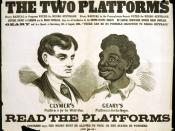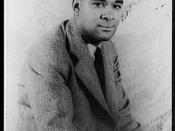What does Richard Wright's depiction of Bigger Thomas suggest about his conceptualization of black subjectivity in the urban North, and to what extent does it depart from the "the New Negro" in Alaine Locke's text?
The Bigger Problem
Alain Locke's essay "The New Negro" explains how the condition of black people during the Harlem Renaissance is evolving to a New Negro who is independent. Locke tells us that the Old Negro was a stereotype not a human being, rather a black subject dominated by a white society. The New Negro, Locke argues, is becoming its own individual subject with a sense of self who is able to act out for oneself. Richard Wright's novel Native Son, through the character Bigger Thomas, depicts the condition of the black subject about 10 years after Locke's predictions. Bigger represents the situations and conditions that all black people of that time period had to deal with.
In Native Son Bigger Thomas is an example of how institutional and individual racism has created a society which leaves the Bigger Thomas's of the world suffering and unable to act for themselves. After reading both of the texts one may see that the character Bigger and many black people of that time period showed little characteristics of the New Negro and actually depart from many of Locke's predictions. Locke's New Negro must fully be understood along with Bigger's situation to see how Locke's foretelling is actually contradicted by Wrights depictions of the way things are.
The New Negro is an entire new form of black people who are individual subjects that can take their lives into their own hands. The Old Negro was more of a myth that an actual human being and it was a perception of what black people were supposed to...


